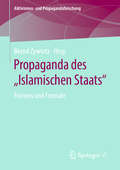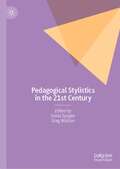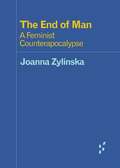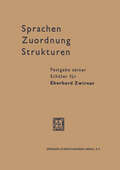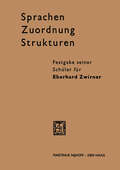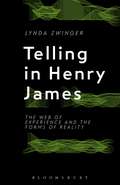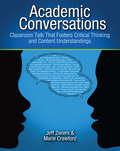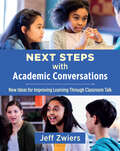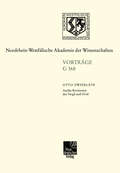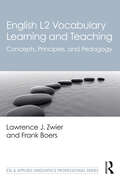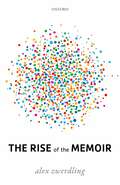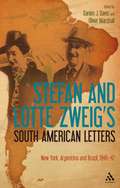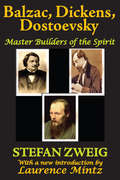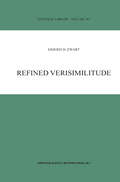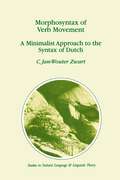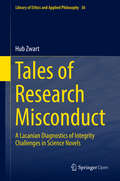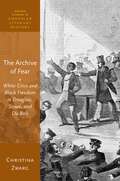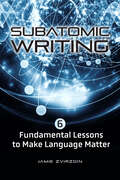- Table View
- List View
Propaganda des „Islamischen Staats“: Formen und Formate (Aktivismus- und Propagandaforschung)
by Bernd ZywietzDie Propaganda der terroristischen Miliz „Islamischer Staat“ hat für Aufsehen gesorgt und die Debatte um das Internet und vor allem das „Social Web“ als Risikotechnologie oder Gefahrenraum mitbestimmt. Dabei setzt der IS auf ein breites Spektrum medialer und gestalterischer Formen und Formate einer globalen, digitalen Medienkultur, um ein internationales Publikum zu erreichen: Online-Videos, anashid (Lieder) und Computerspiele; Internet-Meme, Social Media Posting oder Selfies. Der Sammelband gibt Einblick in die Bandbreite dieser jihadistischen Kommunikate, ihrer Ausdrucks- und Darstellungsweisen und zeigt dabei Möglichkeiten der Einordnung und der Auseinandersetzung auf.
Pedagogical Stylistics in the 21st Century
by Sonia Zyngier Greg WatsonThis edited book provides cutting edge contributions from an international array of prominent experts who discuss the relevance of pedagogical stylistics in relation to diverse contexts and areas, including empirical approaches, corpus stylistics, creative writing, literary-linguistic criticism, students as researchers, critical discourse, academic register, text-world pedagogy, cognitive stylistics, classroom discourse, language of literary texts, L1/L2 education, EFL learners, and multimodal stylistics. Intended as a follow-up to Watson and Zyngier (2007), this volume situates the reader by offering a broad assessment of how the field has developed during the past 15 years and where it stands now. By examining both contemporary research and future challenges, it should be regarded as essential reading for all teachers, researchers, scholars, and students interested in understanding language and how to apply stylistics in educational settings. This book will be of interest to students and scholars working in stylistics, cognitive linguistics, language teaching, applied linguistics, literary studies, and materials development.
The End Of Man: A Feminist Counterapocalypse (PDF) (Forerunners: Ideas First)
by Joanna ZylinskaWhere the Anthropocene has become linked to an apocalyptic narrative, and where this narrative carries a widespread escapist belief that salvation will come from a supernatural elsewhere, Joanna Zylinska has a different take. The End of Man rethinks the prophecy of the end of humans, interrogating the rise in populism around the world and offering an ethical vision of a "feminist counterapocalypse," which challenges many of the masculinist and technicist solutions to our planetary crises. The book is accompanied by a short photo-film, Exit Man, which ultimately asks: If unbridled progress is no longer an option, what kinds of coexistences and collaborations do we create in its aftermath?
Sprachen — Zuordnung — Strukturen: Festgabe seiner Schüler für Eberhard Zwirner
by Eberhard Zwirner Hermann BluhmeTelling in Henry James: The Web of Experience and the Forms of Reality
by Lynda ZwingerTelling in Henry James argues that James's contribution to narrative and narrative theories is a lifelong exploration of how to "tell," but not, as Douglas has it in "The Turn of the Screw" in any "literal, vulgar way." James's fiction offers multiple, and often contradictory, reading (in)directions. Zwinger's overarching contention is that the telling detail is that which cannot be accounted for with any single critical or theoretical lens-that reading James is in some real sense a reading of the disquietingly inassimilable "fictional machinery." The analyses offered by each of the six chapters are grounded in close reading and focused on oddments-textual equivalents to the "particles†? James describes as caught in a silken spider web, in a famous analogy used in "The Art of Fiction†? to describe the kind of "consciousness†? James wants his fiction to present to the reader.Telling in Henry James attends to the sheer fun of James's wit and verbal dexterity, to the cognitive tune-up offered by the complexities and nuances of his precise and rhythmic syntax, and to the complex and contradictory contrapuntal impact of the language on the page, tongue, and ear.
Telling in Henry James: The Web of Experience and the Forms of Reality
by Lynda ZwingerTelling in Henry James argues that James's contribution to narrative and narrative theories is a lifelong exploration of how to "tell," but not, as Douglas has it in "The Turn of the Screw" in any "literal, vulgar way." James's fiction offers multiple, and often contradictory, reading (in)directions. Zwinger's overarching contention is that the telling detail is that which cannot be accounted for with any single critical or theoretical lens-that reading James is in some real sense a reading of the disquietingly inassimilable "fictional machinery." The analyses offered by each of the six chapters are grounded in close reading and focused on oddments-textual equivalents to the “particles” James describes as caught in a silken spider web, in a famous analogy used in “The Art of Fiction” to describe the kind of “consciousness” James wants his fiction to present to the reader.Telling in Henry James attends to the sheer fun of James's wit and verbal dexterity, to the cognitive tune-up offered by the complexities and nuances of his precise and rhythmic syntax, and to the complex and contradictory contrapuntal impact of the language on the page, tongue, and ear.
Academic Conversations: Classroom Talk that Fosters Critical Thinking and Content Understandings
by Jeff Zwiers Marie CrawfordConversing with others has given insights to different perspectives, helped build ideas, and solve problems. Academic conversations push students to think and learn in lasting ways. Academic conversations are back-and-forth dialogues in which students focus on a topic and explore it by building, challenging, and negotiating relevant ideas. In Academic Conversations: Classroom Talk that Fosters Critical Thinking and Content Understandings authors Jeff Zwiers and Marie Crawford address the challenges teachers face when trying to bring thoughtful, respectful, and focused conversations into the classroom. They identify five core communications skills needed to help students hold productive academic conversation across content areas: Elaborating and Clarifying Supporting Ideas with Evidence Building On and/or Challenging Ideas Paraphrasing Synthesizing This book shows teachers how to weave the cultivation of academic conversation skills and conversations into current teaching approaches. More specifically, it describes how to use conversations to build the following: Academic vocabulary and grammar Critical thinking skills such as persuasion, interpretation, consideration of multiple perspectives, evaluation, and application Literacy skills such as questioning, predicting, connecting to prior knowledge, and summarizing An academic classroom environment brimming with respect for others' ideas, equity of voice, engagement, and mutual support The ideas in this book stem from many hours of classroom practice, research, and video analysis across grade levels and content areas. Readers will find numerous practical activities for working on each conversation skill, crafting conversation-worthy tasks, and using conversations to teach and assess. Academic Conversations offers an in-depth approach to helping students develop into the future parents, teachers, and leaders who will collaborate to build a better world.
Academic Conversations: Classroom Talk that Fosters Critical Thinking and Content Understandings
by Jeff Zwiers Marie CrawfordConversing with others has given insights to different perspectives, helped build ideas, and solve problems. Academic conversations push students to think and learn in lasting ways. Academic conversations are back-and-forth dialogues in which students focus on a topic and explore it by building, challenging, and negotiating relevant ideas. In Academic Conversations: Classroom Talk that Fosters Critical Thinking and Content Understandings authors Jeff Zwiers and Marie Crawford address the challenges teachers face when trying to bring thoughtful, respectful, and focused conversations into the classroom. They identify five core communications skills needed to help students hold productive academic conversation across content areas: Elaborating and Clarifying Supporting Ideas with Evidence Building On and/or Challenging Ideas Paraphrasing Synthesizing This book shows teachers how to weave the cultivation of academic conversation skills and conversations into current teaching approaches. More specifically, it describes how to use conversations to build the following: Academic vocabulary and grammar Critical thinking skills such as persuasion, interpretation, consideration of multiple perspectives, evaluation, and application Literacy skills such as questioning, predicting, connecting to prior knowledge, and summarizing An academic classroom environment brimming with respect for others' ideas, equity of voice, engagement, and mutual support The ideas in this book stem from many hours of classroom practice, research, and video analysis across grade levels and content areas. Readers will find numerous practical activities for working on each conversation skill, crafting conversation-worthy tasks, and using conversations to teach and assess. Academic Conversations offers an in-depth approach to helping students develop into the future parents, teachers, and leaders who will collaborate to build a better world.
Next Steps with Academic Conversations: New Ideas for Improving Learning Through Classroom Talk
by Jeff ZwiersDr. Jeff Zwiers, an educational researcher at Stanford University, has spent the last 15 years analyzing classroom conversations to see how they can be better used and improved in classroom settings. Teachers who have worked with him report significant growth in students&’ engagement, content learning, language, creativity, and sense of agency. Zweirs introduced his initial vision for classroom conversations Academic Conversations: Classroom Talk that Fosters Critical Thinking and Content Understanding. His follow-up book, Next Steps with Academic Conversations: New Ideas for Improving Learning Through Classroom Talk , expands the first book with updated classroom strategies and practices. In this new version, teachers will discover: How to introduce buildable ideas and teach students how to develop and support them Equitable classroom discussions and how diverse backgrounds conversing can benefit social skills and emotional intelligence Highlights of new research-based theories on classroom conversation Ways to develop students' confidence in conversation and how classroom skills can apply to real world interactions This resource is the product of his extensive research, co-teaching, and collaborating with a wide range of educators. It was written for busy teachers who want a practical guide for strengthening the quality and quantity of productive conversations in their lessons.
Next Steps with Academic Conversations: New Ideas for Improving Learning Through Classroom Talk
by Jeff ZwiersDr. Jeff Zwiers, an educational researcher at Stanford University, has spent the last 15 years analyzing classroom conversations to see how they can be better used and improved in classroom settings. Teachers who have worked with him report significant growth in students&’ engagement, content learning, language, creativity, and sense of agency. Zweirs introduced his initial vision for classroom conversations Academic Conversations: Classroom Talk that Fosters Critical Thinking and Content Understanding. His follow-up book, Next Steps with Academic Conversations: New Ideas for Improving Learning Through Classroom Talk , expands the first book with updated classroom strategies and practices. In this new version, teachers will discover: How to introduce buildable ideas and teach students how to develop and support them Equitable classroom discussions and how diverse backgrounds conversing can benefit social skills and emotional intelligence Highlights of new research-based theories on classroom conversation Ways to develop students' confidence in conversation and how classroom skills can apply to real world interactions This resource is the product of his extensive research, co-teaching, and collaborating with a wide range of educators. It was written for busy teachers who want a practical guide for strengthening the quality and quantity of productive conversations in their lessons.
Antike Revisionen des Vergil und Ovid (Mathematische Methoden der Technik #368)
by Otto ZwierleinLukian von Samosata erzählt in seinem etwa zwischen 160 und 170 n. ehr. geschriebenen satirischen Roman ,Wahre Geschichten' (aAq31) olqyqllma), daß er einmal von den Säulen des Herakles aus in See stach, um zu erkunden, wo der Ozean ende und wie es mit den jenseits wohnenden Menschen stehe. Auf seiner Fahrt übers Meer, durch die Luft und wieder übers Meer sei er auch auf die Insel der Seligen gekommen. Dort habe er alle Heroen, alle Teilnehmer am Zug gegen Troia und viele berühmte Persönlichkeiten aus der Mythologie und der Geschichte verschiedener Völker angetroffen, darunter auch die Philo sophen Sokrates, Aristipp und Epikur und ihre trinkfesten Anhänger. Platon sei nicht zugegen gewesen, da er ja in der von ihm selbst erdichteten Stadt unter der von ihm entworfenen Staatsverfassung und den von ihm erfundenen Gesetzen lebe. Auch die Stoiker hätten gefehlt, da sie noch immer im Anstieg zur steilen Höhe der Tugend begriffen seien. Von den Akademikern habe es geheißen, daß sie zwar kommen wollten, aber noch immer an sich hielten und nachdächten (En:EXElV OE EU Kat OlaOKEn:u:03m); denn sie könnten noch nicht einmal Gewißheit darüber erlangen, ob es denn eine solche Insel überhaupt gebe, ganz besonders aber fürchteten sie das Gericht vor Rhadamanthys, da sie selbst doch sogar die Möglichkeit, ein Urteil zu fällen, aufgehoben hätten. Nach zwei oder drei Tagen Aufenthalt habe er, so fährt Lukian fort, sich zu dem Dichter Homer begeben und ihn u. a.
English L2 Vocabulary Learning and Teaching: Concepts, Principles, and Pedagogy (ESL & Applied Linguistics Professional Series)
by Lawrence J. Zwier Frank BoersAccessible to experts and non-experts alike, this text is a comprehensive entry to teaching and learning vocabulary in ESL and EFL contexts. Firmly grounded in research, it presents frameworks and methods for teaching vocabulary to English L2 speakers. Overviewing key topics as well as providing in-depth research analyses and critiques, Zwier and Boers address all major areas of vocabulary pedagogy and instruction. Organized in four parts, chapters cover the nature of vocabulary and strands of vocabulary research; curricular approaches; and techniques and activities. Readers are introduced to key topics, including teaching multiword expressions, assessment, discourse, and instruction at different levels. Each chapter includes questions, prompts, and activities to foster discussion. A foundational textbook for courses on L2 instruction and teacher-training courses, it is an essential text for students and scholars in TESOL and Applied Linguistics, and provides the pedagogical grounding future English L2 teachers need to effectively teach vocabulary.
English L2 Vocabulary Learning and Teaching: Concepts, Principles, and Pedagogy (ESL & Applied Linguistics Professional Series)
by Lawrence J. Zwier Frank BoersAccessible to experts and non-experts alike, this text is a comprehensive entry to teaching and learning vocabulary in ESL and EFL contexts. Firmly grounded in research, it presents frameworks and methods for teaching vocabulary to English L2 speakers. Overviewing key topics as well as providing in-depth research analyses and critiques, Zwier and Boers address all major areas of vocabulary pedagogy and instruction. Organized in four parts, chapters cover the nature of vocabulary and strands of vocabulary research; curricular approaches; and techniques and activities. Readers are introduced to key topics, including teaching multiword expressions, assessment, discourse, and instruction at different levels. Each chapter includes questions, prompts, and activities to foster discussion. A foundational textbook for courses on L2 instruction and teacher-training courses, it is an essential text for students and scholars in TESOL and Applied Linguistics, and provides the pedagogical grounding future English L2 teachers need to effectively teach vocabulary.
The Rise of the Memoir
by Alex ZwerdlingThe Rise of the Memoir traces the growth and extraordinarily wide appeal of the memoir. Its territory is private rather than public life, shame, guilt, and embarrassment, not the achievements celebrated in the public record. What accounts for the sharp need writers like Rousseau, Woolf, Orwell, Nabokov, Primo Levi, and Maxine Hong Kingston felt to write (and to publish) such works, when they might more easily have chosen to remain silent? Alex Zwerdling explores why each of these writers felt compelled to write them as that story can be reconstructed from personal materials available in archival collections; what internal conflicts they encountered while trying; and how each of them resisted the private and public pressures to stop themselves rather than pursuing this confessional route, against their own doubts, without a reasonable expectation that such works would be welcome in print, and eventually find an empathetic audience. Reconstructing this process in which a dubious project eventually becomes a compelling product-a "memoir" that will last-illuminates both what was at stake, and why this serially invented open form has reshaped the expectations of readers who welcomed a vital alternative to "the official story."
The Rise of the Memoir
by Alex ZwerdlingThe Rise of the Memoir traces the growth and extraordinarily wide appeal of the memoir. Its territory is private rather than public life, shame, guilt, and embarrassment, not the achievements celebrated in the public record. What accounts for the sharp need writers like Rousseau, Woolf, Orwell, Nabokov, Primo Levi, and Maxine Hong Kingston felt to write (and to publish) such works, when they might more easily have chosen to remain silent? Alex Zwerdling explores why each of these writers felt compelled to write them as that story can be reconstructed from personal materials available in archival collections; what internal conflicts they encountered while trying; and how each of them resisted the private and public pressures to stop themselves rather than pursuing this confessional route, against their own doubts, without a reasonable expectation that such works would be welcome in print, and eventually find an empathetic audience. Reconstructing this process in which a dubious project eventually becomes a compelling product-a "memoir" that will last-illuminates both what was at stake, and why this serially invented open form has reshaped the expectations of readers who welcomed a vital alternative to "the official story."
Stefan and Lotte Zweig's South American Letters: New York, Argentina and Brazil, 1940-42
by Stefan Zweig Lotte Zweig Darién J. Davis Oliver MarshallBorn in Vienna in 1881, Stefan Zweig was one of the most respected authors of his time. Foreseeing Nazi Germany's domination of Europe, Zweig left Austria in 1933. In 1941, following a successful lecture tour of South America and several months in New York, Stefan Zweig and his wife Lotte emigrated to Brazil. Despairing at Europe's future and feeling increasingly isolated, the Zweigs committed suicide together in 1942.Stefan Zweig was an incessant correspondent but as the 1930s progressed, it became difficult for him to maintain contact with friends and colleagues. As Zweig's correspondence all but ceased with the outbreak of World War II, little is known about his final years. Even less is known about Lotte Zweig, his second-wife, secretary and travel-companion. This book provides an analysis of the Zweigs' time together and for the first time reproduces personal letters, written by the couple in Argentina and Brazil, along with editorial commentary. Furthermore, Lotte finally emerges from her husband's shadows, with the letters offering significant insights into their relationship and her experience of exile.
Balzac, Dickens, Dostoevsky: Master Builders of the Spirit
by Stefan ZweigWritten over a period of twenty-five years, this first volume in a trilogy is intended to depict in the life and work of writers of different nationalities--Balzac, Dickens, and Dostoevsky--the world-portraying novelist. Though these essays were composed at fairly long intervals, their essential uniformity has prompted Zweig to bring these three great novelists of the nineteenth century together; to show them as writers who, for the very reason that they contrast with each other, also complete one another in ways which makes them round our concept of the epic portrayers of the world.Zweig considers Balzac, Dickens, and Dostoevsky the supremely great novelists of the nineteenth century. He draws between the writer of one outstanding novel, and what he terms a true novelist--an epic master, the creator of an almost unending series of pre-eminent romances. The novelist in this higher sense is endowed with encyclopedic genius, is a universal artist, who constructs a cosmos, peopling it with types of his own making, giving it laws of gravity that are unique to these fi gures.Each of the novelists featured in Zweig's book has created his own sphere: Balzac, the world of society; Dickens, the world of the family; Dostoevsky, the world of the One and of the All. A comparison of these spheres serves to prove their diff erences. Zweig does not put a valuation on the differences, or emphasize the national element in the artist, whether in a spirit of sympathy or antipathy. Every great creator is a unity in himself, with its own boundaries and specifi c gravity. There is only one specifi c gravity possible within a single work, and no absolute criterion in the sales of justice. This is the measure of Zweig, and the message of this book.
Balzac, Dickens, Dostoevsky: Master Builders of the Spirit
by Stefan ZweigWritten over a period of twenty-five years, this first volume in a trilogy is intended to depict in the life and work of writers of different nationalities--Balzac, Dickens, and Dostoevsky--the world-portraying novelist. Though these essays were composed at fairly long intervals, their essential uniformity has prompted Zweig to bring these three great novelists of the nineteenth century together; to show them as writers who, for the very reason that they contrast with each other, also complete one another in ways which makes them round our concept of the epic portrayers of the world.Zweig considers Balzac, Dickens, and Dostoevsky the supremely great novelists of the nineteenth century. He draws between the writer of one outstanding novel, and what he terms a true novelist--an epic master, the creator of an almost unending series of pre-eminent romances. The novelist in this higher sense is endowed with encyclopedic genius, is a universal artist, who constructs a cosmos, peopling it with types of his own making, giving it laws of gravity that are unique to these fi gures.Each of the novelists featured in Zweig's book has created his own sphere: Balzac, the world of society; Dickens, the world of the family; Dostoevsky, the world of the One and of the All. A comparison of these spheres serves to prove their diff erences. Zweig does not put a valuation on the differences, or emphasize the national element in the artist, whether in a spirit of sympathy or antipathy. Every great creator is a unity in himself, with its own boundaries and specifi c gravity. There is only one specifi c gravity possible within a single work, and no absolute criterion in the sales of justice. This is the measure of Zweig, and the message of this book.
Refined Verisimilitude (Synthese Library #307)
by S.D. ZwartThe subject of the present inquiry is the approach-to-the-truth research, which started with the publication of Sir Karl Popper's Conjectures and Refutations. In the decade before this publication, Popper fiercely attacked the ideas of Rudolf Carnap about confirmation and induction; and ten years later, in the famous tenth chapter of Conjectures he introduced his own ideas about scientific progress and verisimilitude (cf. the quotation on page 6). Abhorring inductivism for its apprecia tion of logical weakness rather than strength, Popper tried to show that fallibilism could serve the purpose of approach to the truth. To substantiate this idea he formalized the common sense intuition about preferences, that is: B is to be preferred to A if B has more advantages andfewer drawbacks than A. In 1974, however, David Millerand Pavel Tichy proved that Popper's formal explication could not be used to compare false theories. Subsequently, many researchers proposed alternatives or tried to improve Popper's original definition.
Morphosyntax of Verb Movement: A Minimalist Approach to the Syntax of Dutch (Studies in Natural Language and Linguistic Theory #39)
by J.-W. ZwartMorphosyntax of Verb Movement discusses the phenomenon of Dutch, present in many Germanic languages, that the finite verb is fronted in main clauses but not in embedded clauses. The theoretical framework adopted is the so-called Minimalist Program of Chomsky (1995), the latest developmental stage of generative grammar. Taking issue with previous analyses, the author argues that phrase structure in Dutch is uniformly head initial, and that the finite verb moves to different positions in subject initial main clauses and in inversion constructions. The book contains lucid and detailed discussion of many theoretical issues in connection with the Minimalist Program, such as the relation between syntax and morphology, the nature of syntactic licensing, and the structure of the functional domain. At the same time, it offers a survey of the properties of Dutch syntax, a discussion of previous analyses of Dutch syntax and a wealth of material from dialects of Dutch and other Germanic languages.
Tales of Research Misconduct: A Lacanian Diagnostics of Integrity Challenges in Science Novels (Library of Ethics and Applied Philosophy #36)
by Hub ZwartThis monograph contributes to the scientific misconduct debate from an oblique perspective, by analysing seven novels devoted to this issue, namely: Arrowsmith by Sinclair Lewis (1925), The affair by C.P. Snow (1960), Cantor’s Dilemma by Carl Djerassi (1989), Perlmann’s Silence by Pascal Mercier (1995), Intuition by Allegra Goodman (2006), Solar by Ian McEwan (2010) and Derailment by Diederik Stapel (2012). Scientific misconduct, i.e. fabrication, falsification, plagiarism, but also other questionable research practices, have become a focus of concern for academic communities worldwide, but also for managers, funders and publishers of research. The aforementioned novels offer intriguing windows into integrity challenges emerging in contemporary research practices. They are analysed from a continental philosophical perspective, providing a stage where various voices, positions and modes of discourse are mutually exposed to one another, so that they critically address and question one another. They force us to start from the admission that we do not really know what misconduct is. Subsequently, by providing case histories of misconduct, they address integrity challenges not only in terms of individual deviance but also in terms of systemic crisis, due to current transformations in the ways in which knowledge is produced. Rather than functioning as moral vignettes, the author argues that misconduct novels challenge us to reconsider some of the basic conceptual building blocks of integrity discourse.Except where otherwise noted, this book is licensed under a Creative Commons Attribution 4.0 International License. To view a copy of this license, visit http://creativecommons.org/licenses/by/4.0/.
The Archive of Fear: White Crisis and Black Freedom in Douglass, Stowe, and Du Bois (Oxford Studies in American Literary History)
by Christina ZwargFocusing on U.S. slavery and its aftermath in the nineteenth century, The Archive of Fear explores the traumatic force field that continued to inflect discussions of slavery and abolition both before and after the Civil War. It challenges the long-assumed distinction between psychological and cultural-historical theories of trauma, discovering a virtual dialogue between three central U. S. writers and Sigmund Freud concerning the traumatic response of slavery's perpetrators. A strain of trauma theory and practice comes alive in the temporal and spatial disruptions of New World slavery-and The Archive of Fear shows how key elements of that theory still inform the infrastructure of race relations today. It argues that trauma theory before Freud first involves a return to an overlap between crisis, insurrection, and mesmerism found in the work of Frederick Douglass, Harriet Beecher Stowe, and W. E. B. Du Bois. Mesmer's "crisis state" has long been read as the precursor to hypnosis, the tool Freud famously rejected when he created psychoanalysis. But the story of what was lost to trauma theory when Freud adopted the "talk cure" can be told through cultural disruptions of New World slavery, especially after mesmerism arrived in Saint Domingue where its implication in the Haitian revolution in both reality and fantasy had an impact on the history of emancipation in the United States.
The Archive of Fear: White Crisis and Black Freedom in Douglass, Stowe, and Du Bois (Oxford Studies in American Literary History)
by Christina ZwargFocusing on U.S. slavery and its aftermath in the nineteenth century, The Archive of Fear explores the traumatic force field that continued to inflect discussions of slavery and abolition both before and after the Civil War. It challenges the long-assumed distinction between psychological and cultural-historical theories of trauma, discovering a virtual dialogue between three central U. S. writers and Sigmund Freud concerning the traumatic response of slavery's perpetrators. A strain of trauma theory and practice comes alive in the temporal and spatial disruptions of New World slavery-and The Archive of Fear shows how key elements of that theory still inform the infrastructure of race relations today. It argues that trauma theory before Freud first involves a return to an overlap between crisis, insurrection, and mesmerism found in the work of Frederick Douglass, Harriet Beecher Stowe, and W. E. B. Du Bois. Mesmer's "crisis state" has long been read as the precursor to hypnosis, the tool Freud famously rejected when he created psychoanalysis. But the story of what was lost to trauma theory when Freud adopted the "talk cure" can be told through cultural disruptions of New World slavery, especially after mesmerism arrived in Saint Domingue where its implication in the Haitian revolution in both reality and fantasy had an impact on the history of emancipation in the United States.
Subatomic Writing: Six Fundamental Lessons to Make Language Matter
by Jamie ZvirzdinSee science writing fundamentals afresh through a subatomic lens!In Subatomic Writing, Johns Hopkins University instructor Jamie Zvirzdin goes bravely into uncharted territory by offering a totally new kind of guide for writing about science—from the subatomic level up! Subatomic Writing teaches readers that the building blocks of language are like particles in physics. These particles, combined and arranged, form something greater than their parts: all matter in the literary universe. The six levels of language covered in this guide create writing that illuminates and energizes the reader to feel, learn, change, and act. This interdisciplinary approach helps scientists, science writers, and editors improve their writing in fundamental areas as they build from the sounds in a word to the pacing of a paragraph. These areas include• Sound and sense• Word classes• Grammar and syntax• Punctuation• Rhythm and emphasis• Pacing and coherenceEqually helpful for students who need to learn how to write clearly about science and scientists who need to hone their writing skills to create more effective course material, papers, and grant applications, this guide builds confidence in writing abilities as old skills are taught in new, exciting ways. Each lesson provides exercises that build on each other, strengthening readers' capacity to communicate ideas and data, all while learning basic particle physics along the way.
